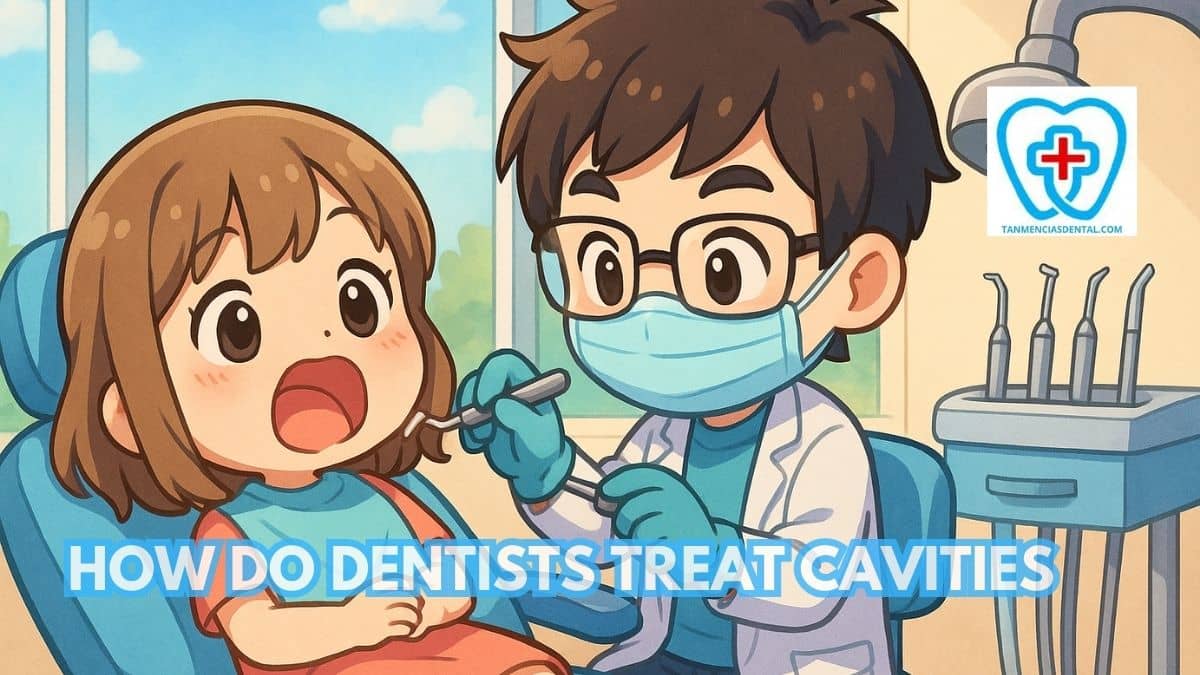Cavities are holes in your teeth caused by tooth decay.
If not treated, they can lead to pain, infection, or even loss of the tooth.
Dentists use different methods to stop the damage and make the tooth strong again.
We’ll explain how dentists treat cavities, from finding the problem to taking care of your teeth after treatment.
Knowing what to expect can help you feel more confident during your dental visit.
1. Spotting the Enemy: How Dentists Diagnose Cavities
Dentists diagnose cavities during routine checkups using both visual exams and dental X-rays.
During the visual exam, they check for dark spots, small holes, or changes in the color and texture of the tooth enamel.
Tooth enamel is the hard outer layer of the tooth that protects it from decay, and any visible damage to it may be a sign of a cavity.
However, not all cavities can be seen with the eyes alone, so dentists use X-rays to detect hidden decay, especially between teeth or under existing fillings.
These X-rays show changes in the density of the enamel, helping dentists find early-stage cavities before they get worse.
If a cavity is found, the dentist will explain the condition and discuss treatment options such as fillings made with resin, a tooth-colored material used to repair the damage.
Catching cavities early allows for simpler, less invasive treatments and helps keep your teeth strong and healthy.
🦷 The Benefits of Whitening Trays Compared to Other Teeth Whitening Options
2. Early Action, Big Results: The Importance of Early Cavity Detection
Detecting cavities early makes treatment simpler and less invasive.
When cavities are caught early, they can often be treated with a simple filling, avoiding more complex procedures like root canals.
Early detection also means less discomfort and lower treatment costs.
Regular dental checkups are essential for early detection, as they allow dentists to monitor your oral health closely.
Taking action early can save your teeth and prevent future dental issues.
🦷 Why Parents Should Choose a Pediatric Dentist Instead of a General Dentist
3. How Dentists Choose the Right Treatment for Your Cavity
Dentists decide the best treatment for cavities by considering several important factors.
The size of the cavity matters because smaller holes typically only need fillings, while larger areas of decay might require crowns.
The cavity’s location also matters; teeth used for chewing usually need stronger, longer-lasting materials.
Dentists also look at how deep the decay has spread to determine if a root canal is needed to remove infected tissue inside the tooth.
Additionally, your dental history and personal preferences about how the tooth looks can influence the type of treatment your dentist recommends.
🦷 How Dental Care for Children Differs from Adult Dentistry
4. Taking the Sting Out: Anesthesia Options for Cavity Treatment
To ensure a pain-free experience during cavity treatment, dentists use local anesthesia.
Common anesthetics include lidocaine, which numbs the area around the affected tooth.
This numbing agent is usually administered via a small injection, which takes effect quickly.
Anesthesia helps patients remain comfortable and relaxed during the procedure.
It is an essential part of the treatment process, making even more extensive dental work manageable without pain.
🦷 Tips for Finding the Best Dental Clinic for Consultations in Marikina

5. Fixing the Problem: The Filling Procedure Explained
The filling procedure begins with the dentist numbing the area around the affected tooth.
Once the area is numb, the dentist removes the decayed portion of the tooth using a drill or laser.
The cleaned cavity is then filled with a suitable material to restore the tooth’s shape and function.
The dentist shapes and polishes the filling to ensure it fits well with the surrounding teeth.
This procedure helps prevent further decay and restores the tooth’s structural integrity.
🦷 The Importance of Regular Dental Checkups for Your Overall Health
6. More Than One Way to Fill a Hole: Types of Cavity Fillings
There are several types of cavity fillings, each with its own advantages and disadvantages.
Amalgam fillings are durable and suitable for back teeth, but are noticeable due to their silver color.
Composite fillings match the color of natural teeth, making them ideal for visible areas, but they may not last as long as amalgam.
Gold fillings are durable and long-lasting, but they are more expensive and noticeable.
Ceramic fillings are also tooth-colored and resistant to staining, providing a good balance of aesthetics and durability.
🦷 Advantages of Visiting a Denture Clinic Instead of a General Dental Clinic
7. When Cavities Go Deep: Root Canals and Crowns
If a cavity extends to the tooth’s pulp, a root canal may be necessary.
During a root canal, the dentist removes the infected pulp and cleans the inside of the tooth.
The tooth is then sealed and usually capped with a crown to restore its strength and appearance.
Crowns are custom-made to fit over the tooth, providing protection and a natural look.
This procedure saves the tooth from extraction and prevents further infection.
🦷 How Periodontal Cleaning Is Different from Standard Dental Cleaning
8. A Last Resort: Tooth Extraction for Severe Cavities
In cases where the cavity has caused extensive damage and the tooth cannot be saved, extraction is required.
Tooth extraction involves removing the entire tooth from its socket in the bone.
This procedure is usually done under local anesthesia to minimize discomfort.
After extraction, options like dental implants or bridges can replace the missing tooth.
Dentists strive to preserve natural teeth whenever possible, making extraction a last resort.
🦷 Understanding When Dental Deep Cleaning Is Needed
9. Keeping Your Smile Healthy: Post-Treatment Care
After cavity treatment, it’s essential to follow the dentist’s instructions for post-treatment care.
This includes avoiding hard or sticky foods that could damage the filling.
Maintaining good oral hygiene by brushing twice a day and flossing daily is crucial to preventing future cavities.
Regular dental checkups allow the dentist to monitor the treated area and ensure it heals properly.
Proper post-treatment care helps maintain the health and longevity of the treated tooth.
🦷 Can Using an Electric Toothbrush Harm Your Gums?
10. Managing Discomfort: Pain Medication After Cavity Treatment
Some discomfort or sensitivity is normal after cavity treatment.
Over-the-counter pain medications like ibuprofen or acetaminophen can help manage this discomfort.
Dentists may also recommend specific pain relief options based on the procedure and individual needs.
It’s important to follow the dosage instructions and avoid chewing on the treated side until the numbness wears off.
If pain persists or worsens, contacting the dentist for further evaluation is essential.
🦷 Why Interdental Brushes Are Key to Maintaining Daily Oral Hygiene
11. Prevention is Key: Brushing, Flossing, and Avoiding Cavities
Preventing cavities involves a combination of good oral hygiene practices and dietary choices.
Brushing teeth at least twice a day with fluoride toothpaste helps remove plaque and prevent decay.
Flossing daily removes food particles and plaque between teeth that brushing misses.
Limiting sugary snacks and drinks can also reduce the risk of cavities.
Regular dental checkups and professional cleanings play a vital role in maintaining oral health and preventing cavities.
🦷 Highly Qualified Dentists in Marikina
👨⚕️ Conclusion
Professional cavity treatment is essential for maintaining oral health and preventing more serious dental issues.
Understanding the steps involved in treating cavities can help alleviate anxiety about dental visits.
Regular checkups and good oral hygiene practices are key to preventing cavities and ensuring timely treatment when needed.
Trusting your dentist and following their advice can lead to a healthier, cavity-free smile.
Prioritize your oral health by making regular dental care a part of your routine.
😊 Self-Promotion
At Tan-Mencias Dental Clinic in Parang, Marikina City, we are dedicated to providing exceptional dental care with a friendly smile.
Whether you need a routine checkup, cavity treatment, or any other dental service, our experienced team is here to help.
You can reach out to us with any questions or to schedule an appointment by calling 9171451074, messaging us through our Facebook page, or using our website’s contact form.
We’re committed to making your dental experience as comfortable and positive as possible.
Visit us today, and let us take care of your smile!

